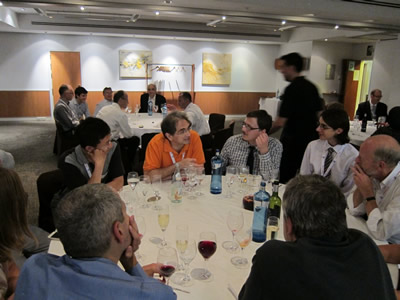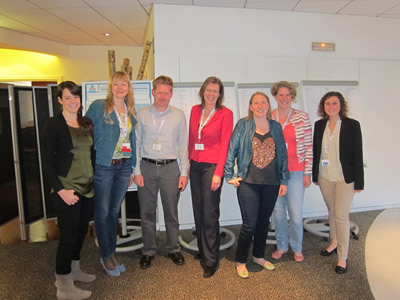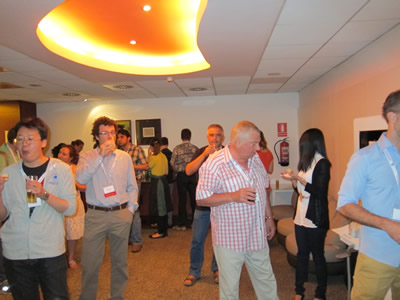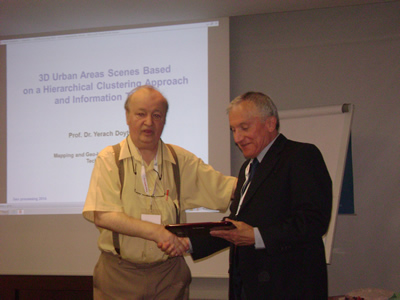ALLSENSORS 2024 - The Ninth International Conference on Advances in Sensors, Actuators, Metering and Sensing
May 26, 2024 - May 30, 2024
ALLSENSORS 2024: Call for Papers
Onsite and Online Options: In order to accommodate a large number of situations, we are offering the option for either physical presence or virtual participation (pdf slides or pre-recorded videos).
The ALLSENSORS 2024 conference continues an event series covering related topics on theory practice and applications of sensor devices, techniques, data acquisition and processing, and on wired and wireless sensors and sensor networks.
Sensors and sensor networks have a great potential of providing diverse services to broad range of applications, not only on science and engineering, but equally importantly on issues related to critical infrastructure protection and security, healthcare, the environment, energy, food safety, and the potential impact on the quality of all areas of life.
Sensor networks and sensor-based systems support many applications today above ground. Underwater operations and applications are quite limited by comparison. Most applications refer to remotely controlled submersibles and wide-area data collection systems at a coarse granularity. Other remote sensing domains and applications are using special sensing devices and services.
Transducers and actuators complement the monitoring and control and constitute an area of interest related to sensors. They make use of specific sensor-based measurements and convey appropriate control actions.
ALLSENSORS 2024 is intended to serve as a forum for researchers from the academia and the industry, professionals, standard developers, policy makers, investors and practitioners to present their recent results, to exchange ideas, and to establish new partnerships and collaborations. The topics could be on techniques and applications, best practices, awareness and experiences as well as future trends and needs (both in research and practice) related to all aspects of sensor-based applications and services.
We solicit both academic, research, and industrial contributions. We welcome technical papers presenting research and practical results, position papers addressing the pros and cons of specific proposals, such as those being discussed in the standard fora or in industry consortia, survey papers addressing the key problems and solutions on any of the above topics short papers on work in progress, and panel proposals.
Industrial presentations are not subject to the format and content constraints of regular submissions. We expect short and long presentations that express industrial position and status.
Tutorials on specific related topics and panels on challenging areas are encouraged.
The topics suggested by the conference can be discussed in term of concepts, state of the art, research, standards, implementations, running experiments, applications, and industrial case studies. Authors are invited to submit complete unpublished papers, which are not under review in any other conference or journal in the following, but not limited to, topic areas.
All topics and submission formats are open to both research and industry contributions.
ALLSENSORS 2024 conference tracks:
Trends on sensing and sensors types
Secure and energy-efficient sensors; Opportunistic sensing; Secure embedded visual sensing; Sensor calibration; Interference resilience in sensors-based systems; Delay-tolerant sensors; Time-sensitive sensing; Virtual sensing; Energy-delay conservation; Ubiquitous sensors; Sensors for organic/non-organic materials/environments; Short/long/adaptive transmission range sensors; Sensors and meta-data; Cryogenic sensors; Film-based sensors; Lifetime- and latency-aware sensors; Low/high pressure sensors; High-speed signal sensors; Chemical sensors; Cross-sensitive sensors; Tracking sensors; Ultra-wide band sensors; Underground sensors; Underwater sensors; Mobility sensing; Sensing stream data; Dense/coarse powder sensors; Low/high temperature sensors; Bio-acoustic monitoring sensors; Hazardous gases sensors; Proximity sensors
Trends on sensing systems
Sensors and smart homes; Distributed visual tracking systems; Sensors- and IoT-based systems; Smart micro-grid sensing; Sensing smart cities; Body-sensor networks; Sensors and IoD (Internet-of-Drones); Industrial sensing; Flooding sensing; IoT (Internet of Things) sensors; Smartphones as sensors; Real-time video surveillance systems; Mobile urban sensing applications; Wearable sensors; Sensing forest environments; Mobile crowdsensing systems; Air pollution sensing systems; Atmospheric sensing systems; Sensor-based user authentication systems
Sensors types
Mechanical sensors; Digital sensors; Optical sensors; Optical fiber sensors; Temperature sensors; Pressure sensors and transducers; Acoustic and ultrasonic sensors; Reflectometry sensors; Humidity sensors; Gas sensors; Frequency output sensors; Rotational speed sensors; Chemical sensors; Film-based sensors; Quartz crystal microbalance sensors; Biosensors; Inertial sensors; Gyroscopic sensors; Capillary sensors; Silicon-based sensors; Textile-based sensors
Quantum sensors and measurements
Sensors based on quatum phenomena (spectroscopy, imaging, etc.); Superconduction-based sensors; Transition edge sensors (TES); Superconducting quantum interference devices (SQUID); Gamma-ray and alpha particle detectors; TES bolometers; Polarization sensitive bolometers; Arrays of low temperature microbolometers; Superconducting x-ray spectrometers; Multi-chroic detector array; Kinetic inductance detectors; Industrial and scientific materials analysis; Precision measurements for wavelengths; Accurate measurements; Cosmic microwave background measurements; Measuring small energy; Superconducting readout electronics to measure and amplify the signals from the detectors
Cryogenic sensors and systems
Cryogenic temperature sensors; Cryogenic particle detectors; Calorimetric particle detection; Phonon particle detection; Superconducting nanowire single-photon detectors; Roton detectors; Multifunctional cryogenic sensors; Cryogenic Hall sensors; Cryogenic non-contact displacement sensors; Cryogenic instrumentation; Cryogenic temperature monitoring systems
Biosensors and bio-oriented electronics
Enzyme biosensors; Immunosensors; Natural and synthetic receptors; Electronic noses; DNA chips and nucleic acid sensors; Organism- and whole cell-based biosensors; Printed biosensors and organic electronics; Single-cell detection/analysis; Nanomaterials and nanoanalytical systems; Electrochemical biosensors; Biodetection; Materials and biosensors; Applications for biosensors; Commercial biosensors, manufacturing and markets; Bio-MEMS; Wearable skin sensors
Sensor technologies and materials
Biological, chemical sensors and arrays; Electromagnetic sensors; Multi-sensor fusion technology; Smart and intelligent sensors; Sensor interfacing and signal conditioning; Nanomaterials and electronics technology for sensors; Semiconductor materials for sensors; Polymer materials for Sensors; Nuclear magnetic resonance; Embedded sensors; Wearable sensors; RFID sensors; Underwater sensors; Wireless and wired sensors; Sensing materials – inorganic, organic, polymeric, composite, formulated, nanomaterials; Sensing materials stability; Sensor manufacturability
Aerospace sensors and sensor systems
Meteorological sensors and sensor systems for flight support; Aerospace photonics sensors and systems; Radar Systems; Non-destructive testing for aerospace
Sensor-related techniques and methods
Modern error theory and compensation techniques; Sensor Calibration; Self-calibration; Reliability of measurement systems; Precision and ultra-precision instruments; Modeling and simulation technologies for sensor-based systems; Universal frequency-to-digital conversion interface; Universal transducers and sensors interface; Performance analysis of sensors; Methods for multivariate analysis of sensor responses
Transducers, actuators
Electrical to mechanical energy conversion; Linear actuators; Manual actuators; Hydraulic actuators; Pneumatic actuators; Vacuum actuators; Computer vision instruments; Fluid power transmission and control; Mechatronics; Microelectronics; Wireless communication technology; Air and underwater communication
Metering/Measurements
Measurement theory; Automation instruments; Instruments and measuring technology; Instrument design and measurement theory; Mechanical measurements; Measurement in nanotechnology; Measurement in biomedicine; Measurement in environment (pollution, Arctic, humidity, etc.); Microwave measurements; Measurement of the noise and vibration; Measurement of force and strain; Measurement of displacement and proximity; Nondestructive testing; Light/Radiation monitoring; Computer online measurements; Sensor-based visualization and detecting systems; Single- and multi-parameter measurements.
Sensing systems
MEMS and NEMS; Online measurements; Remote sensing and telemetry; Virtual instruments; Thermometry and nanothermometry; Digital sensors and sensor systems; Industrial robots and automation; Inertial sensor systems; Remote Sensing for Climatology Models; Remote Sensing for Environmental Modeling; Remote sensing on atmosphere, clouds, temperature, ozone; Remote sensing on glaciers, polar fields, sea ice; Remote sensing on ocean waters, surface and subsurface water currents; Wind-driven currents, coastal waters, lakes; Remote sensing on earthquakes, hurricanes, late freezing, air currents; Remote sensing on large disasters, volcanoes, wildfires, marine oil spills, landslide hazards, tornadoes; Remote sensing on earth resources, aerosols, dams surveillance, geology, reservoirs; Remote sensing on agriculture; Tropical forests, deserts, vegetation dynamics, crop estimation; Remote sensing on hydro, flooding, drought, rainfalls, snowstorms; Remote sensing on urban traffic, public and commercial transportation, airports, naval ports
Sensor-system algorithms, protocols, communication and computation
Architectures, protocols and algorithms of sensor networks; Smart sensor systems; Data acquisition sensor-based systems; Energy-aware sensor systems; Resource allocation, services, QoS and fault tolerance in sensor networks; Smart Sensors for building surveillance; Social sensing systems; Deployments and implementations of sensor networks; Internet on Things sensor-based systems; Domain-oriented sensor systems; Web-base monitoring and control
Deadlines:
Submission | Mar 09, 2024 |
Notification | Mar 31, 2024 |
Registration | Apr 16, 2024 |
Camera ready | Apr 26, 2024 |
Deadlines differ for special tracks. Please consult the conference home page for special tracks Call for Papers (if any).
INSTRUCTION FOR THE AUTHORS
Authors of selected papers will be invited to submit extended versions to one of the IARIA Journals.
Publisher: XPS (Xpert Publishing Services)
Archived: ThinkMindTM Digital Library (free access)
Prints available at Curran Associates, Inc.
How to submit to appropriate indexes.
Only .pdf or .doc files will be accepted for paper submission. All received submissions will be acknowledged via an automated system.
Contribution types
- regular papers [in the proceedings, digital library]
- short papers (work in progress) [in the proceedings, digital library]
- ideas: two pages [in the proceedings, digital library]
- extended abstracts: two pages [in the proceedings, digital library]
- posters: two pages [in the proceedings, digital library]
- posters: slide only [slide-deck posted on www.iaria.org]
- presentations: slide only [slide-deck posted on www.iaria.org]
- demos: two pages [posted on www.iaria.org]
FORMATS
Only .pdf or .doc files will be accepted for paper submission. All received submissions will be acknowledged via an automated system.
Final author manuscripts will be 8.5" x 11", not exceeding 6 pages; max 4 extra pages allowed at additional cost.
Helpful information for paper formatting for MS Word can be found here.
There is a community provided LaTeX template: the CTAN package iaria (with full IARIA formatting rules, including IARIA citation style, but for providing citation style it is tightly bound to pdflatex+biblatex+biber). In addition, there is also iaria-lite (not bound to pdflatex+biblatex+biber, but compatible with any TeX stack; thus, it cannot provide the IARIA citation formattings, but only the titlepage and content-related IARIA formatting rules). Based on the iaria package, there is a minimal working example as Overleaf template. When you are using the LaTeX templates, please still adhere to the additional editorial rules.
Slides-based contributions can use the corporate/university format and style.
Your paper should also comply with the additional editorial rules.
Once you receive the notification of contribution acceptance, you will be provided by the publisher an online author kit with all the steps an author needs to follow to submit the final version. The author kits URL will be included in the letter of acceptance.
We would recommend that you should not use too many extra pages, even if you can afford the extra fees. No more than 2 contributions per event are recommended, as each contribution must be separately registered and paid for. At least one author of each accepted paper must register to ensure that the paper will be included in the conference proceedings and in the digital library, or posted on the www.iaria.org (for slide-based contributions).
CONTRIBUTION TYPE
Regular Papers (up to 6-10 page article -6 pages covered the by regular registration; max 4 extra pages allowed at additional cost- ) (oral presentation)
These contributions could be academic or industrial research, survey, white, implementation-oriented, architecture-oriented, white papers, etc. They will be included in the proceedings, posted in the free-access ThinkMind digital library and sent for indexing. Please submit the contributions following the instructions for the regular submissions using the "Submit a Paper" button and selecting the appropriate contribution type. 12-14 presentation slides are suggested.
Short papers (work in progress) (up to 4 pages long) (oral presentation)
Work-in-progress contributions are welcome. These contributions represent partial achievements of longer-term projects. They could be academic or industrial research, survey, white, implementation-oriented, architecture-oriented, white papers, etc. Please submit the contributions following the instructions for the regular submissions using the "Submit a Paper" button and selecting the contribution type as work in progress. Contributors must follow the conference deadlines, describing early research and novel skeleton ideas in the areas of the conference topics. The work will be published in the conference proceedings, posted in the free-access ThinkMind digital library and sent for indexing. For more details, see the Work in Progress explanation page. 12-14 presentation slides are suggested.
Ideas contributions (2 pages long) (oral presentation)
This category is dedicated to new ideas in their very early stage. Idea contributions are expression of yet to be developed approaches, with pros/cons, not yet consolidated. Ideas contributions are intended for a debate and audience feedback. Please submit the contributions following the instructions for the regular submissions using the "Submit a Paper" button and selecting the contribution type as Idea. Contributors must follow the conference deadlines, describing early research and novel skeleton ideas in the areas of the conference topics. The work will be published in the conference proceedings, posted in the free-access ThinkMind digital library and sent for indexing. For more details, see the Ideas explanation page. 12-14 presentation slides are suggested.
Extended abstracts (2 pages long) (oral presentation)
Extended abstracts summarize a long potential publication with noticeable results. It is intended for sharing yet to be written, or further on intended for a journal publication. Please submit the contributions following the instructions for the regular submissions using the "Submit a Paper" button and selecting the contribution type as Extended abstract. Contributors must follow the conference deadlines, describing early research and novel skeleton ideas in the areas of the conference topics. The work will be published in the conference proceedings, posted in the free-access ThinkMind digital library and sent for indexing. 12-14 presentation slides are suggested.
Posters (paper-based, two pages long) (oral presentation)
Posters are intended for ongoing research projects, concrete realizations, or industrial applications/projects presentations. The poster may be presented during sessions reserved for posters, or mixed with presentation of articles of similar topic. A two-page paper summarizes a presentation intended to be a POSTER. This allows an author to summarize a series of results and expose them via a big number of figures, graphics and tables. Please submit the contributions following the instructions for the regular submissions using the "Submit a Paper" button and selecting the contribution type as Poster Two Pages. Contributors must follow the conference deadlines, describing early research and novel skeleton ideas in the areas of the conference topics. The work will be published in the conference proceedings, posted in the free-access ThinkMind digital library and sent for indexing. 8-10 presentation slides are suggested. Also a big Poster is suitable, used for live discussions with the attendees, in addition to the oral presentation.
Posters (slide-based, only) (oral presentation)
Posters are intended for ongoing research projects, concrete realizations, or industrial applications/projects presentations. The poster may be presented during sessions reserved for posters, or mixed with presentation of articles of similar topic. The slides must have comprehensive comments. This type of contribution only requires a 8-10 slide-deck. Please submit the contributions following the instructions for the regular submissions using the "Submit a Paper" button and selecting the contribution type as Poster (slide-only). The slide-deck will be posted, post-event, on www.iaria.org.
8-10 presentation slides are suggested. Also a big Poster is suitable, used for live discussions with the attendees, additionally to the oral presentation.
Presentations (slide-based, only) (oral presentation)
These contributions represent technical marketing/industrial/business/positioning presentations. This type of contribution only requires a 12-14 slide-deck. Please submit the contributions following the submission instructions by using the "Submit a Paper" button and selecting the contribution type as Presentation (slide-only). The slide-deck will be posted, post-event, on www.iaria.org.
12-14 presentation slides are suggested.
Demos (two pages) [posted on www.iaria.org]
Demos represent special contributions where a tool, an implementation of an application, or a freshly implemented system is presented in its alfa/beta version. It might also be intended for thsoe new application to gather the attendee opinion. A two-page summary for a demo is intended to be. It would be scheduled in special time spots, to ensure a maximum attendance from the participants. Please submit the contributions following the submission instructions by using the "Submit a Paper" button and selecting the contribution type as Demos. The Demos paper will be posted, post-event, on www.iaria.org.
Tutorial proposals
Tutorials provide overviews of current high interest topics. Proposals should be for 2-3 hour long. Proposals must contain the title, the summary of the content, and the biography of the presenter(s). The tutorial slide decks will be posted on the IARIA site.
Please send your proposals to tutorial proposal
Panel proposals
The organizers encourage scientists and industry leaders to organize dedicated panels dealing with controversial and challenging topics and paradigms. Panel moderators are asked to identify their guests and manage that their appropriate talk supports timely reach our deadlines. Moderators must specifically submit an official proposal, indicating their background, panelist names, their affiliation, the topic of the panel, as well as short biographies. The panel slide deck will be posted on the IARIA site.
Please send your proposals to panel proposal



















































